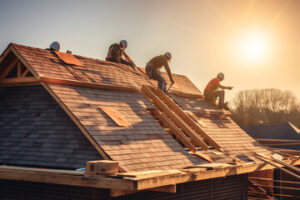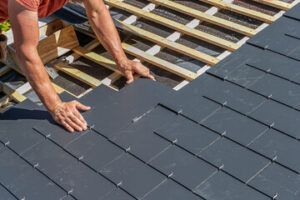Your roof comes into contact with many environmental factors that can damage it. These problems may necessitate roof repair, ranging from replacing damaged shingles to addressing underlying issues.

If you notice water stains in your ceiling or walls, or a loss of granules from your gutters, it is time to call for a professional inspection. Inspect the shingles, flashing, joints, and chimney for any signs of leaks. Contact Columbus Roof Repair for professional help.
A roof protects your home from the elements. But just like any protector, it needs maintenance to stay effective. When problems occur, early identification and repair can prevent them from snowballing into a costly replacement.
Shingles are usually the first sign of trouble, a weakening of your roof’s defense that allows moisture to seep in and cause ceiling leaks. Keeping an eye out for these seven common shingle issues will help you spot problems before they turn into major headaches.
Dislodged Shingles
Strong gusty winds can wreak havoc on a shingle roof, particularly older or cheaper 3-tab shingles. The sand-like material can become dislodged, leaving the fiberglass underlay visible. Dislodged shingles are relatively easy to identify from the ground, and they should be repaired right away to avoid leaks and further damage.
Cracked or Broken Shingles
Shingle damage often results from ageing, weathering, and other natural occurrences. But it can also be caused by improper installation or lack of maintenance. Cracked or broken shingles can allow water to seep through the roof, causing structural damage and leaks.
Curling or Buckling Shingles
A curling or buckling shingle is typically a sign of old age, but it can be a warning of underlying problems that require immediate attention. This damage allows moisture to penetrate the underlayment, leading to rot and leaks.
Hail Damage
When hail hits your roof, it can dent or even remove the granules that cover the asphalt layer of the shingle. This loss of granules reduces the shingle’s ability to resist UV rays, making it vulnerable to damage and deterioration. This damage is not always obvious from the ground, but may be evident in a loss of granules in gutters and downspouts.
The easiest way to fix this issue is to replace the damaged shingle with one that is of the same type and color. A professional can do this for you, but if you’re willing to tackle it yourself, start by loosening the shingle above it with a pry bar and removing the nails holding it in place with a hammer claw. Slide the new shingle into place, and secure it with roofing nails, using additional roofing cement to seal the edges.
Leaking Gutters
A gutter’s role is simple—they collect roof water and direct it away from the home. However, gutters are prone to leakage due to clogging and ageing. In these cases, water can escape the gutters and cause structural damage to your home or foundation, as well as wall and ceiling stains and dampness in interior rooms.
Leaking gutters require prompt repair to prevent further water intrusion and resulting damage to the property. For instance, if the leaking water is causing staining on your walls or ceilings, it could cause mold and mildew that affect the integrity of the interior structure of your home. It could also wreak havoc on electrical systems, creating short circuits and fire hazards.
Gutters become leaking for a variety of reasons, including clogging, loose fasteners and damaged flashing. In some cases, a roofer may need to replace the entire gutter system if it is severely damaged or outdated. In other cases, a simple fix can restore the gutters to proper working condition.
The primary reason why gutters can leak is because they’re clogged. Leaves, twigs and debris build up in the gutters over time and create separation in areas between the gutters and the house fascia boards. This hinders the flow of water off the roof and into the gutters, allowing stagnant water to degrade the gutters and leak into your home.
In addition, over time, the fasteners that attach the gutters to the fascia boards can loosen. This is usually due to the weight of the accumulated leaves, twigs and debris. Loose fasteners can cause the gutter to shift and separate from the fascia board, resulting in leaks.
If the gutters are still in good shape, they can be repaired by tightening the loose fasteners or replacing them with new ones. This can be done by a professional roofing contractor as part of a routine roof inspection.
Damaged Flashing
Flashing is the thin strips of metal installed around roof penetrations, such as chimneys, vents, skylights, and roof valleys, to prevent water infiltration. If not properly sealed, flashing can become damaged and allow water to seep into your home. Identifying and repairing flashing damage early is essential for preventing water infiltration and other costly roof problems.
Flashing typically consists of copper, galvanized steel, or aluminum. While these materials are durable, they can still experience damage and require repair or replacement over time. Symptoms of flashing damage include rust or corrosion, cracks or gaps, and loose or missing sections. Leaks are another common sign of flashing issues, and can be caused by improper installation, strong winds, or aging.
Ideally, flashing should be installed by a professional roofer. However, if you do choose to perform the repair yourself, it’s important to follow proper steps to ensure lasting results. Using the right tools and techniques will help you make repairs quickly and easily, without damaging surrounding roofing materials or creating additional leaks. It’s also a good idea to keep detailed records of your roof maintenance and repair projects, including before-and-after photos, measurements, materials used, and professional services hired. This documentation can be useful for future reference, warranty claims, and when selling your home.
If you’re not comfortable climbing on your roof, consider scheduling a yearly inspection by a professional roofing expert. Regular inspections can help detect any potential flashing damage, and can be performed during a routine roof maintenance visit.
Remember, a professional roofer will have the appropriate safety gear and equipment to safely conduct your roof inspection. Prior to working on your roof, be sure to wear sturdy work boots, safety glasses, and a ladder that’s in good condition.
It’s normal for foundation shifts to occur over time, which can impact your roof’s structure. The shifting soil may cause flashing to come apart from certain areas of your roof. To minimize this risk, schedule a yearly roof inspection with a Lyons Roofing specialist. They can recommend the best course of action to protect your home’s foundation and prevent water damage.
Mold
Mold is a type of fungi that forms when moisture is allowed to accumulate on building materials. This is usually because of a roof leak, but can also be the result of poor ventilation. Mold can cause many health problems in humans and should be dealt with immediately if it is detected.
Mold spores are airborne and can travel to other locations where conditions are favorable for mold growth. These conditions include a warm, moist environment and an available food source such as cellulose (found in wood, paper, and carpet). When spores land on a damp surface that is covered with organic material, they begin to grow by growing hyphae. These hyphae may have a velvety or woolly texture and vary in color from black to green. If the spores are trapped indoors, they can spread rapidly to other areas and be difficult to eradicate.
While most molds are not toxic, it is important to identify and remove mold from your roof because they can promote the deterioration of roofing materials such as shingles. In addition, the spores can trigger allergic reactions in sensitive individuals and lead to respiratory issues such as coughing, wheezing, itchy eyes, and skin rashes. Some types of mold can also produce mycotoxins, which are poisonous to humans and can cause neurological problems.
The best way to remove mold from a roof is by using a bleach solution and then washing the area with clean water. It is important to use a bleach solution instead of a power washer, as the latter can damage shingles and other roofing materials. Alternatively, you can hire a professional roof cleaner to handle the task for you.
Regular roof inspections should be performed to identify and repair any issues that can cause mold to grow. This includes identifying any moisture sources that could be contributing to the problem and making repairs as needed. It is also a good idea to inspect your attic space for signs of a roof leak. An experienced roofer can help to determine if the mold is simply the result of a roof leak or if it is indicative of other problems such as wood rot or clogged gutters.
